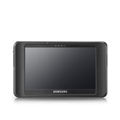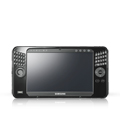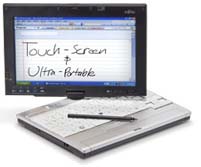
|
|
|
|
|
|
SkyPad2 vs. Other Tablet PCs
The SkyPad2 is a type of computing device commonly called a Tablet PC. There are other Tablet PCs on the market, available from many manufactures. There are also many makers of very inexpensive, small laptops that are commonly called netbooks.
This document gives an overview of the differences between the SkyPad hardware and some of the more popular Tablet PCs and netbooks but is certainly not an all-inclusive list.
» Samsung Q1 » Motion Computing LS 800 » Fujitsu 1630 » Netbooks
SkyPad2 vs. Samsung Q1


The Samsung Q1 is actually a family of products, not a single product, that was one of the first entries into the Tablet PC market. The devices range in price from about $750 to over $1350. The current versions of the device have a screen resolution of 1024 x 600, come with 1 GB of RAM, a spinning hard drive and generally run Windows Vista. It is a true tablet in that there is no built-in keyboard but you can add an external one via either a USB cord or wirelessly with Bluetooth (not available on some older Q1 models).
SkyPad2 Advantages
Faster CPU. The Q1 models range in speed but never as fast as the SkyPad2.
Pure, State of the Art, Intel Components. Many of the Q1 models use an older type of CPU from Intel that is not nearly as good at multitasking (single core vs. dual core) as the CPU used in the SkyPad2. Moreover, some Q1 units use an "off-brand" CPU and video chip set provided by a company called Via that, for many reasons, we very strongly recommend against. The Intel video chip set used in the SkyPad is also newer, providing much better performance for Voyager since Voyager (the navigational application used on the SkyPad) uses a technology called Microsoft DirectX for extremely fast performance.
Better Screen Resolution. The Q1 has higher screen resolution than the SkyPad2 and this is actually bad. While perhaps counter-intuitive, a larger number of pixels on a screen that is approximately the same size means that each pixel is physically smaller. Smaller pixels means smaller, harder to read text and smaller, harder to click buttons.
Integrated Keyboard Means Usable Laptop. The SkyPad2 is a convertible tablet, meaning that the screen swivels. In one rotation, the screen covers the keyboard and you interact with the device solely by touching the screen. In the other rotation, the SkyPad2 looks like a small laptop with a keyboard that is very usable. In "laptop mode," the SkyPad2 also has a standard touchpad below the keyboard, like most laptops.
Better Price. Even the cheapest Q1, which uses the Via chipset that we very recommend against, is much more expensive than the SkyPad2 once you add the costs of adding a second GB of RAM (SkyPad2 comes with 2 GB, the Q1 with just 1 GB), adding Voyager software, and adding a GPS.
Customized Windows and Voyager. Each SkyPad2 has been carefully tuned by Seattle Avionics engineers to, as they put it, "remove the garbage" from Windows. That means no pre-installed trial versions of anything, faster start up time, fewer annoying Windows messages, cleaner Windows Desktop, larger icons and an overall streamlined experience specifically designed for cockpit use. We also created a SkyPad Controller application that makes it especially easy to change screen brightness, rotate the screen or shut-down the SkyPad. Finally, each SkyPad2 comes with Voyager and all current data, customized and pre-installed for you. That is, when you get it, it's ready to go with your pilot profile, your plane profile and all the default settings you like.
Battery Life. The Q1, like most laptops and tablets, has about 2 hours of battery life. The SkyPad's battery lasts at least 4.5 hours.
Q1 Advantage
Slimmer. None
SkyPad2 vs. Motion Computing LS 800The Motion Computing LS 800 is the grand-daddy of Tablet PCs, being introduced in 2005 and discontinued in 2008. It's a pure Tablet PC (no keyboard) running Microsoft Windows XP. The units shipped with 1 GB of RAM but could be upgraded to 2 GB. The units came with spinning drives but can be retrofitted with a solid-state drive. They were also available with either a standard LCD screen or a super-bright screen called ViewAnywhere. While the units are no longer being manufactured, they can be found on eBay.
SkyPad2 Advantages
Doesn't Overheat. The LS 800 has a major design flaw in that the system runs so hot that it often turns itself off to protect from overheating or, at least, dims the screen and slows the CPU to draw less power. The system has no internal fan because the marketing people at Motion Computing thought it would only be used in air-conditioned offices, not on hot tarmacs in the Florida sun. The SkyPad2 runs cool and includes a fan, like most laptops.
Much Faster CPU. The LS 800 has a very old, slow CPU by current standards. The SkyPad2 has a very modern Intel Atom chip that is both faster and uses much less power than the CPU in the LS 800.
Much Faster Video Card. The LS 800 has a video chip that was actually the subject of a class-action lawsuit against Microsoft because Microsoft said that it was capable of running Windows Vista when, in fact, it was much too slow to do that. The chip inside the SkyPad is a modern Intel graphics chip that is more than capable for anything Voyager needs it to do.
Better Screen Resolution. The LS 800 has an 800 x 600 screen resolution and the SkyPad2 is 1024 x 600. This means the SkyPad2 can display more information on the screen than the LS 800. Increasing the screen resolution, beyond a certain point, can actually be bad because it can mean everything is smaller on the screen (see discussion of most of the other machines on this page) but the SkyPad's screen is physically a little larger than the LS 800's, which pretty much makes up for the difference.
Integrated Keyboard Means Usable Laptop. The SkyPad2 is a convertible tablet, meaning that the screen swivels. In one rotation, the screen covers the keyboard and the you interact with the device solely by touching the screen. In the other rotation, the SkyPad2 looks like a small laptop with a keyboard that is very usable. In "laptop mode," the SkyPad2 also has a standard touchpad below the keyboard, like most laptops.
Customized Windows and Voyager. Each SkyPad2 has been carefully tuned by Seattle Avionics engineers to, as they put it, "remove the garbage" from Windows. That means no pre-installed trial versions of anything, faster start up time, fewer annoying Windows messages, cleaner Windows Desktop, larger icons and an overall streamlined experience specifically designed for cockpit use. We also created a SkyPad Controller application that makes it especially easy to change screen brightness, rotate the screen or shut-down the SkyPad2. Finally, each SkyPad2 comes with Voyager and all current data, customized and pre-installed for you. That is, when you get it, it's ready to go with your pilot profile, your plane profile and all the default settings you like.
Battery Life. The LS 800, like most laptops and tablets, has about 2 - 2.5 hours of battery life. With an optional extended battery, this goes to about 3-3.5 but, as the units are dated and batteries lose their ability to charge over time, few LS 800 units will have anywhere near this charge. The SkyPad's battery lasts at least 4.5 hours.
LS 800 Advantage
None
SkyPad2 vs. Fujitsu 1630

Fujitsu makes a number of highly-respected tablets and has for several years. The current small form-factor device is the P1630 although its predecessors, the P1610 and P1620, are very similar to the 1630. Like the SkyPad2, the Fujitsu devices are convertible tablets with integrated keyboards that work well in either tablet or laptop modes.
SkyPad2 Advantages
Price. The Fujitsu 1630 line begins at $1800 and goes above $2,300 (not including a solid-state drive). They also come with just 1 GB of RAM and adding the second GB of RAM is $150.
Touchpad vs. StickPoint. The SkyPad2 keyboard has a standard touch pad below it for moving the mouse while in laptop mode. The Fujitsu line has no touch pad but a small "stick" in the middle of the keyboard that moves the mouse. This type of pointing device is not found on many machines and will be unfamiliar to most people. The exception might be IBM/Lenovo ThinkPad users who use the TrackPoint stick that IBM created. However, even the ThinkPad line also a touchpad below the keyboard so even many ThinkPad users probably use the touchpad.
Screen Resolution. The 1630 has higher screen resolution than the SkyPad2 and this is actually bad. While perhaps counter-intuitive, a larger number of pixels on a screen that is approximately the same size means that each pixel is physically smaller. Smaller pixels means smaller, harder to read text and smaller, harder to click buttons.
Customized Windows and Voyager. Each SkyPad2 has been carefully tuned by Seattle Avionics engineers to, as they put it, "remove the garbage" from Windows. That means no pre-installed trial versions of anything, faster start up time, fewer annoying Windows messages, cleaner Windows Desktop, larger icons and an overall streamlined experience specifically designed for cockpit use. We also created a SkyPad Controller application that makes it especially easy to change screen brightness, rotate the screen or shut-down the SkyPad2. Finally, each SkyPad2 comes with Voyager and all current data, customized and pre-installed for you. That is, when you get it, it's ready to go with your pilot profile, your plane profile and all the default settings you like.
Battery Life. The 1630, like most laptops and tablets, has about 2 - 2.5 hours of battery life. The SkyPad's battery lasts at least 4.5 hours.
1630 Advantage
Faster CPU. The 1630 and the 1620 come with an Intel Core 2 Duo processor. This is significantly faster than the Atom CPU used in the SkyPad2. For Voyager, the difference isn't significant as Voyager is at least as dependent on graphics performance as CPU performance and the SkyPad2 has a newer video chip. However, for other Windows applications, you may notice the difference. The Core 2 Duo also draws considerably more power than the Atom CPU so battery life will be worse.
SkyPad vs. NetbooksThe phrase netbook refers to a class of inexpensive, small laptops made by many vendors. These machines typically cost between $200 and $400. Physically, they are very similar to the SkyPad2 with one major exception: They are standard laptop form-factors so you cannot flip the screen to hide the keyboard or touch the screen to click items. Many of them, especially the less expensive ones, also have non-Intel CPU and graphic chips which can dramatically affect the performance and reliability of Voyager. Other common features such as Bluetooth may also be missing. And the inexpensive netbooks seldom have both a multi-touch screen and the version of Windows 7 required to take advantage of it (Windows 7 Home Premium).
SkyPad2 Advantages
Touchscreen vs. TrackPad. All netbooks have a laptop standard trackpad below the keyboard. The SkyPad2 has this, too, and it's very useful when in laptop mode. However, using a small trackpad to move a mouse and click the screen is virtually impossible while in-flight. The SkyPad's touchscreen feature is vastly easier to use.
Yoke Mounting. A device with a laptop form-factor cannot be yoke-mounted because the keyboard must sit at approximately a 90 degree angle to the screen. The SkyPad2, in tablet mode, is easy to yoke mount.
Pure, State of the Art, Intel Components. Some netbooks use an "off-brand" CPU and video chip set provided by a company called Via that, for many reasons, we very strongly recommend against. The Intel video chip set used in the SkyPad is also newer, providing much better performance for Voyager since Voyager (the navigational application used on the SkyPad2) uses a technology called Microsoft DirectX for extremely fast performance.
1 GB vs. 2 GB. Most netbooks, to keep costs down, come with just 1 GB of RAM. The SkyPad2 comes with 2 GB, which makes a considerable performance difference for Voyager and other Windows applications.
Customized Windows and Voyager. Each SkyPad2 has been carefully tuned by Seattle Avionics engineers to, as they put it, "remove the garbage" from Windows. That means no pre-installed trial versions of anything, faster start up time, fewer annoying Windows messages, cleaner Windows Desktop, larger icons and an overall streamlined experience specifically designed for cockpit use. We also created a SkyPad Controller application that makes it especially easy to change screen brightness, rotate the screen or shut-down the SkyPad2. Finally, each SkyPad2 comes with Voyager and all current data, customized and pre-installed for you. That is, when you get it, it's ready to go with your pilot profile, your plane profile and all the default settings you like.
Battery Life. The battery life of netbooks will vary by machine but the SkyPad's battery lasts at least 4.5 hours, which is longer than most netbooks we've seen.
Netbook Advantage
Price. A netbook by itself may cost as little as $200. However, this is quite misleading as such device typically comes with just 1 GB of RAM (you need 2 GB for Voyager so add another $50), doesn't include the cost of the GPS ($100), doesn't include the Voyager software ($300), and doesn't include a data subscription ($75). Many of the lowest-end netbooks don't have Bluetooth wireless capabilities either, which makes adding a GPS much more difficult. Most importantly, however, the 'naked' netbook doesn't come pre-installed with Voyager and data for all 50 states and the version of Windows running on the machine will not have been carefully tuned for in-flight use so you should consider the cost of your time to download and install the data and tune Windows.